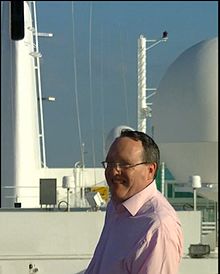Stephen Payne (naval architect)
Stephen Payne, OBE, RDI, FREng, FRINA is a British naval architect. He has worked on the designs of approximately 40 passenger ships for the Carnival Corporation, including the Cunard ocean liner RMS Queen Mary 2. He is currently an independent maritime consultant and is an educational advocate for engineering careers.
Stephen Michael Payne was born in London, England circa 1960. He was educated in the local public schools including the Catford Boys’ School, where two of its instructors would have a key role in shaping his career. His interest in ocean liners began at age 5 when the BBC children’s television program Blue Peter featured a tour of the RMS Queen Elizabeth. He would later state that he was immediately captivated by the ship. His interest in ships intensified during a 1969 family visit to the then new Queen Elizabeth 2 in Southampton and he also observed the SS United States, on one of her last transatlantic crossings, arriving in port. In 1972 the program’s magazine described the destruction by fire of the ex-Queen Elizabeth in Hong Kong harbor and ended with the statement “…nothing like her will ever be built again.” With encouragement from a Catford English instructor Payne wrote a letter of complaint to the program arguing that they were wrong, another ship to rival her would indeed be built and he would design it. The program applauded his ambition but cautioned him not to be discouraged if it never happened.
When the time came for him to consider university studies however his career counselors discouraged Payne from any engineering career as it was then seen as having limited job prospects. They advised him to instead study chemistry and he enrolled at Imperial College London. After one year of study he met with his former physics instructor from Catford who agreed that Payne had been badly advised, and helped him obtain funding to transfer to the University of Southampton’s Ship Science program. While there, he also enrolled in the University Royal Naval Unit to experience how ships responded at sea. After graduating in 1984 with a B.Sc.(Hons) in ship science, he accepted a position at Marconi Radar. His role was to advise the company on aspects of ship motion and ship design.
...
Wikipedia

